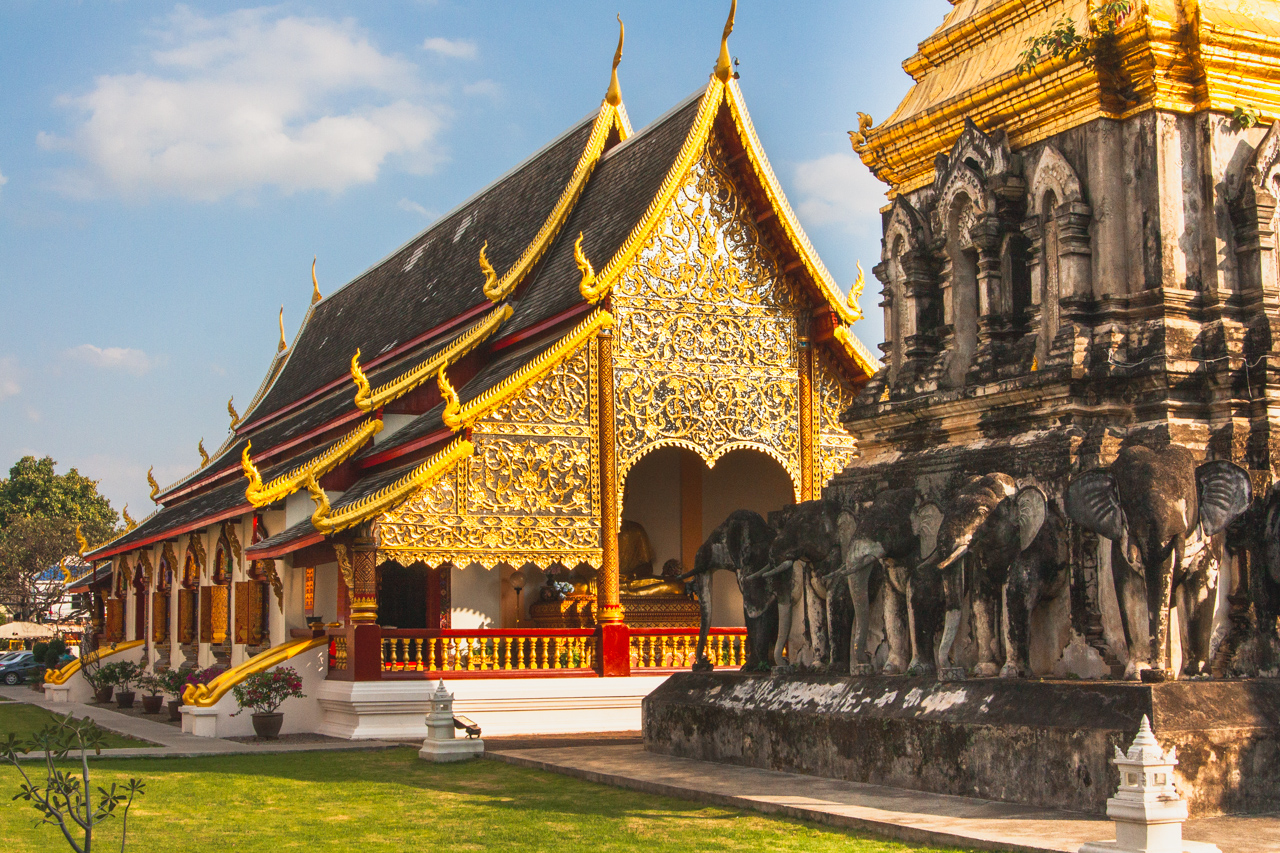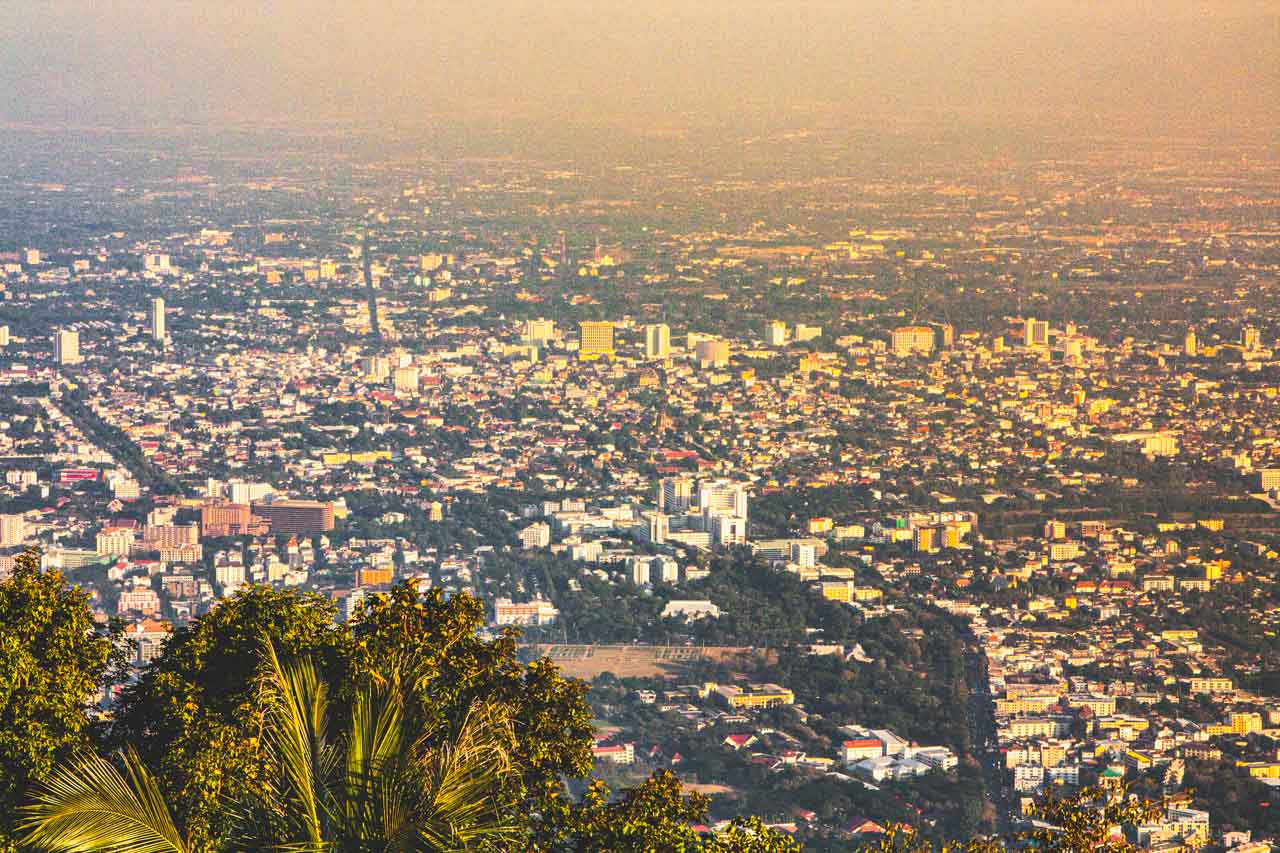Wondering what to see in Chiang Mai? This is one of those places that doesn’t shout about its attractions – it slowly pulls you into its rhythm.
Chiang Mai sits among the mountains of northern Thailand and has something soft about it.
The quiet of temples in the morning, the smell of incense, green courtyards hidden behind old city walls, and markets that live at their own pace.
Here, tradition isn’t on display, and modernity enters quietly, without disturbing the balance.
In this guide, I’ll show you Chiang Mai as I remember it. Temples worth visiting without rushing.
Places where it feels good to sit for a while. Restaurants and cafes you return to not for photos, but for the taste and atmosphere.
I’ll also share practical tips that really come in handy on the ground and help you feel this city, instead of just “checking it off.”
If you’re looking for Chiang Mai with soul, come along. Let’s start.
Planning a broader trip through Thailand? Check out my complete guide to Thailand to help you plan the perfect route.
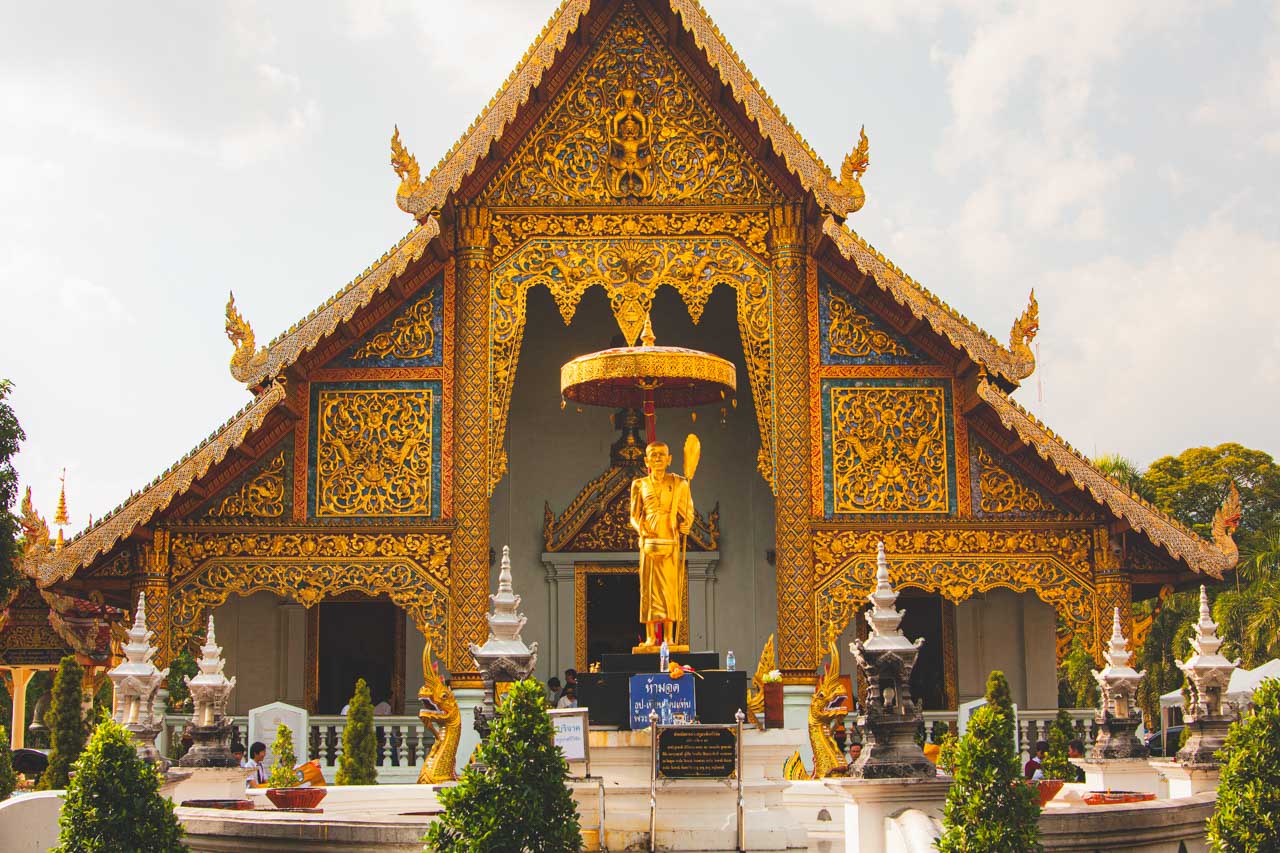
Chiang Mai, Thailand: A Gentle Introduction
Chiang Mai is northern Thailand’s largest city and a place where history is still felt in everyday rhythms.
The former capital of the Lanna Kingdom, called the “Kingdom of a Million Rice Fields,” has retained its own character to this day, clearly distinguishing it from the rest of the country.
For centuries, Lanna remained under the influence of the neighboring Ayutthaya Kingdom while maintaining considerable independence.
It wasn’t until 1775 that it was incorporated into the Kingdom of Siam, today’s Thailand. But that history didn’t disappear with the borders on the map.
In Chiang Mai, the Lanna heritage still lives. You can see it in the calm, wooden temple architecture, in decorative details, in local cuisine, and in residents’ daily customs.
This city doesn’t tell its story directly. You have to feel it, walking through the old city, sitting at a market, or stopping by a temple outside peak hours.
For many people, Chiang Mai is their first encounter with northern Thailand. For others, it’s a place to return to – to slow down and immerse yourself in a culture that still has its own rhythm.
If you’re interested not just in what to see, but also in how to understand this place, you’re in the right spot.
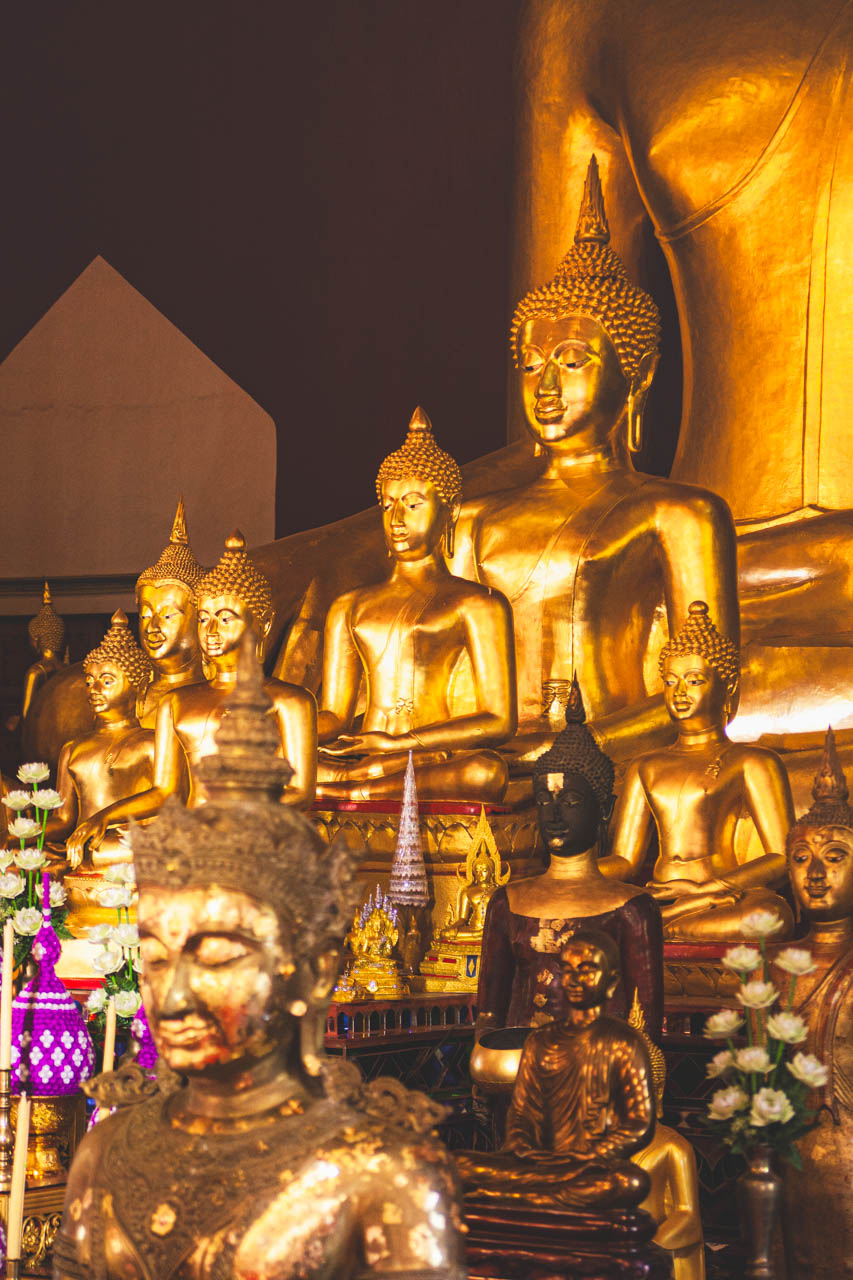
What to See in Chiang Mai
Wat Phra Singh
In Chiang Mai itself and its immediate vicinity, there are over three hundred temples, with thirty-six located within the old city walls.
It’s easy to get lost in all this, so it’s good to start exploring Chiang Mai from a place that naturally introduces you to the city’s rhythm. For me, that starting point is the 14th-century Wat Phra Singh complex.
This is one of the most important and beautiful temples in Chiang Mai, but it doesn’t have any pretension.
It’s spacious, green, and gives you a sense of peace, especially if you visit early in the morning or late afternoon. It’s a good place to slow down for a moment and get comfortable with the local spirituality.
At the heart of the complex is one of northern Thailand’s most important Buddha figures, the Buddha Phra Singh, from which the temple takes its name.
The word “singh” means lion in Thai, a symbol of strength and protection, often found in Lanna region architecture.
The statue’s origin remains a mystery to this day. According to local legends, it was brought all the way from Ceylon, present-day Sri Lanka.
Regardless of how much truth versus myth is in this story, Wat Phra Singh has something very authentic about it.
It’s a place you don’t so much tour as simply absorb, wandering without a plan between pavilions and quiet courtyards.

Every year on April 13th, during the Songkran festival (Thai New Year), the Buddha Phra Singh statue leaves Viharn Lai Kham.
It’s carried through Chiang Mai’s streets in a procession, and residents pay their respects by gently sprinkling water on the figure.
It’s a gesture of cleansing and good beginnings – very symbolic, yet surprisingly simple and natural.
Besides Viharn Lai Kham and the main hall Viharn Luang, the complex also includes the Ubosot, or ordination hall. Its interior made the biggest impression on us.
There are unusual wax figures depicting monks in realistic poses. They’re so faithfully reproduced that for a moment it’s hard to believe they’re not real people.
This is one of those places where silence makes a bigger impression than any decorations, and where you instinctively speak more quietly, even if no one asks you to.
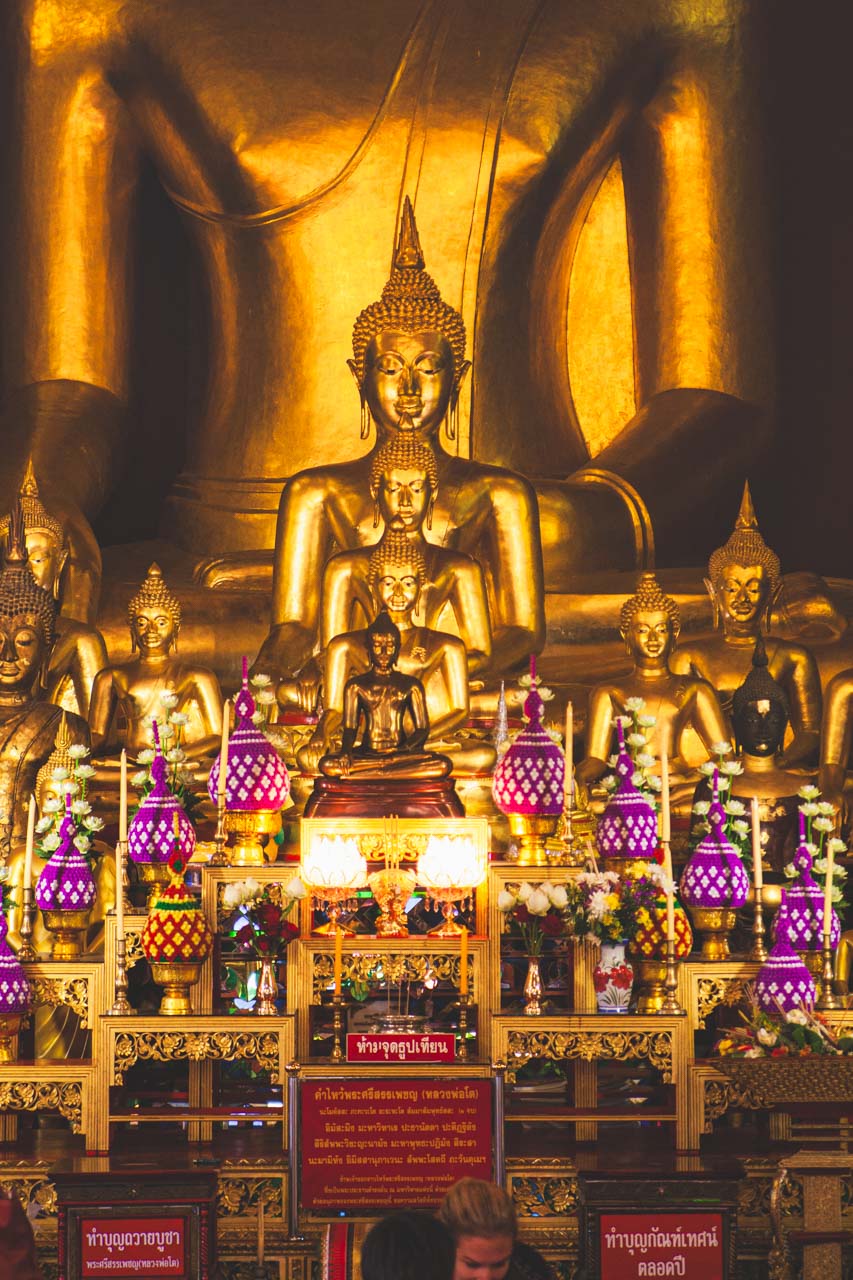
Wat Chedi Luang
Another place that naturally appears on the Chiang Mai sightseeing route is Wat Chedi Luang.
This is where you’ll find the largest chedi in the city and one of the most recognizable symbols of the old town.
The massive, austere chedi was built in the late 14th century, between 1385 and 1402. It still dominates the area and is hard to miss, even if you’re not planning temple visits with a checklist in hand.
Its scale is impressive, but not overwhelming. Rather, it reminds you of time and how long this place has been important to the city.
The chedi once housed the Emerald Buddha, one of Thailand’s most precious treasures.
In 1545, a powerful earthquake seriously damaged the structure, and since then the chedi has never returned to its original form.
What we see today is a reconstruction and testimony to how fragile even monumental architecture can be.
Wat Chedi Luang has something very honest about it. It doesn’t try to pretend to former glory.
The ruin, silence, and raw walls make this place feel different from richly decorated temples. More reflective, more focused.
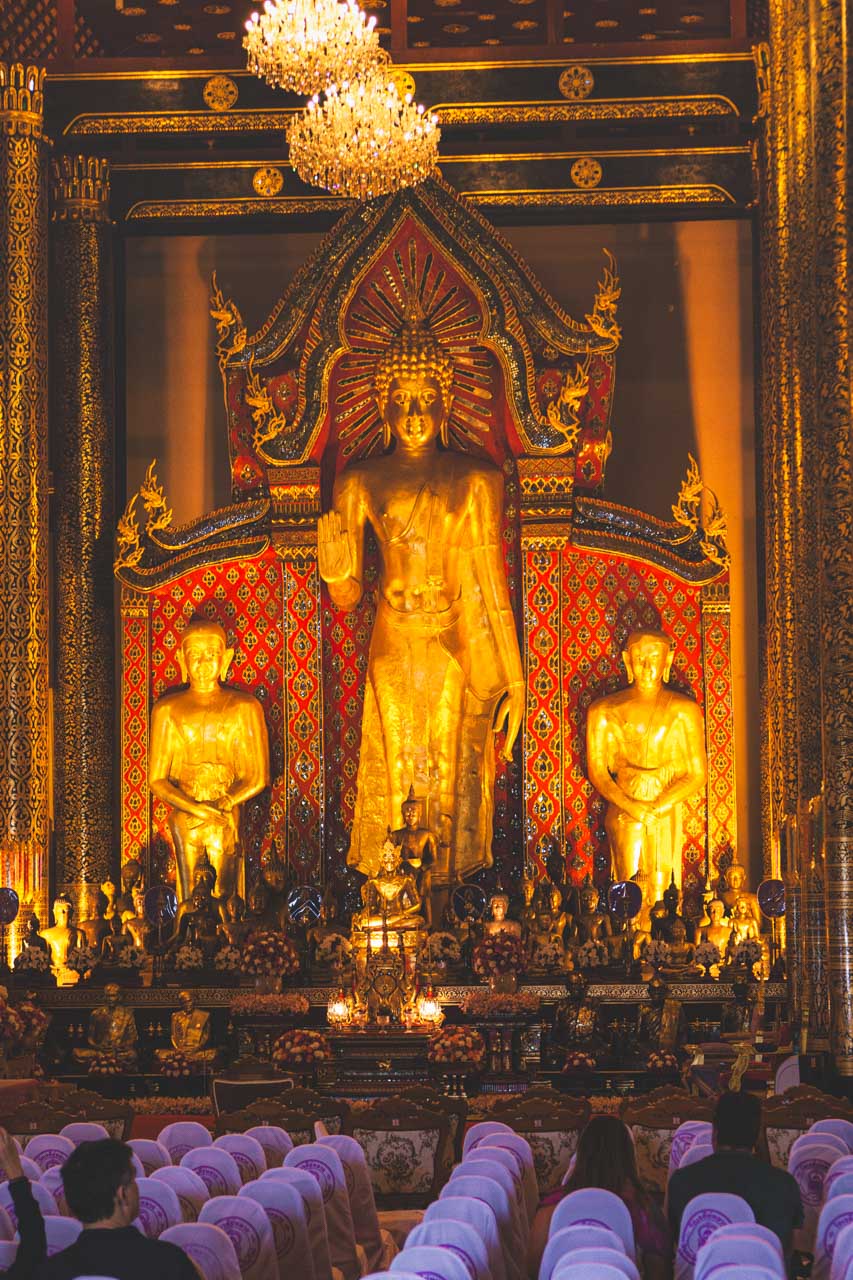
Wat Phan Tao
Not far from Wat Chedi Luang is another place that’s easy to overlook, but stays in your memory for a long time.
Wat Phan Tao is one of Chiang Mai’s most atmospheric temples and completely different from those built of masonry and monumental.
The temple was built from teak wood, which immediately gives it a warm, almost homey character.
The wood darkens over time, smells different than stone, and makes the whole place seem softer and more intimate. This isn’t a temple you pop into for a moment. Rather, you sit on the side and just observe.
It’s supposedly most beautiful during evening prayers, when dusk falls and the silhouettes of monks in orange robes stand out sharply against the dark wood.
Even if you don’t happen to catch that moment, Wat Phan Tao still has exceptional silence and peace.
The teak it’s built from is famous for its durability and weather resistance. Thanks to this, the temple has survived years in excellent condition, maintaining its character and authenticity.
This is one of those places that doesn’t need publicity to make an impression.
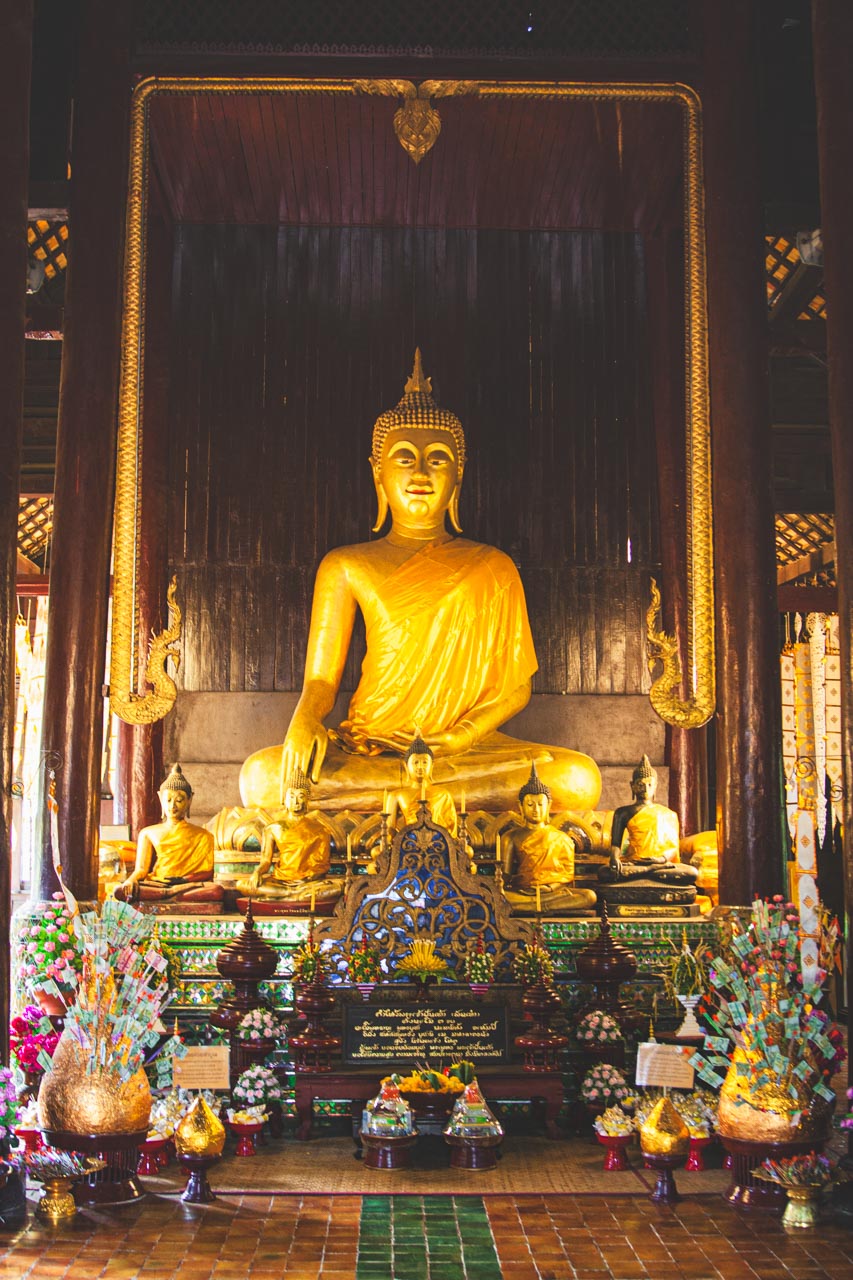
Dreaming of authentic Thailand, without tourist traps?
Every week I share proven tips from my travels across Asia on the newsletter – from hidden temples to local restaurants you remember for years.
Bonus for new readers: Complete Thai Recipe Collection (8 recipes including Tom Yum, Yellow Curry, Pad Thai + 5 more) + my secret Chiang Mai local spots!
Wat Chiang Man
After visiting Wat Phan Tao, it’s worth heading to Wat Chiang Man, Chiang Mai’s oldest temple. It was founded in 1297, and this is the best place to feel the city’s beginnings and its original energy.
On the complex grounds is the distinctive Chedi Chang Lom, surrounded by fifteen stone elephant statues. According to beliefs, sacred Buddha relics are stored inside the chedi.
This is one of those places where you naturally slow your pace and view it in silence rather than in a hurry.
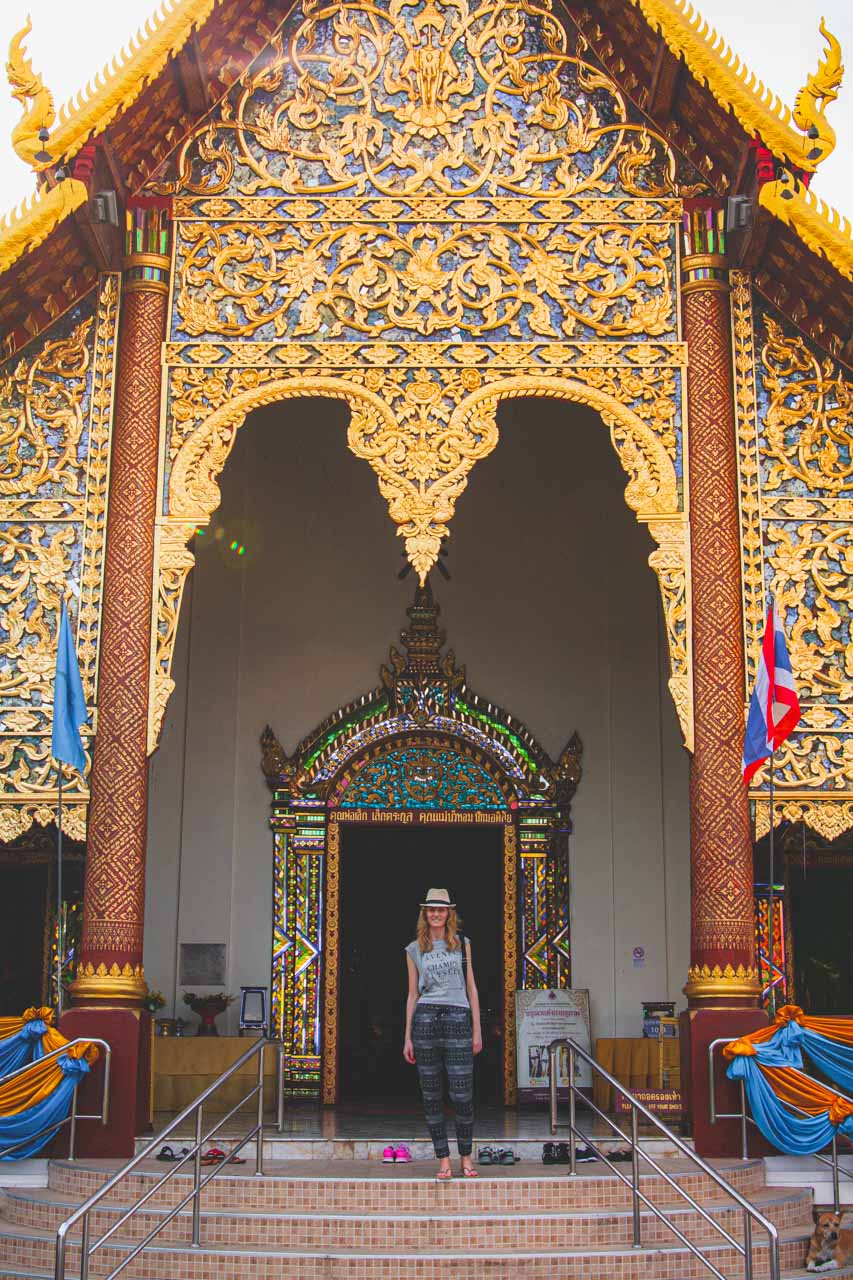
Also eye-catching are two viharns, or prayer halls. The larger one houses a 15th-century Buddha figure, while the smaller contains two particularly important statues: Phra Sae Tang Khamani and Phra Sila.
Each has its own meaning and history, but even without knowing it, you can feel this is a space surrounded by natural respect.
Wat Chiang Man doesn’t need rich decorations to impress.
Its power lies in simplicity and in a sense of continuity that makes Chiang Mai stop being just another point on the map and start being a place with depth.
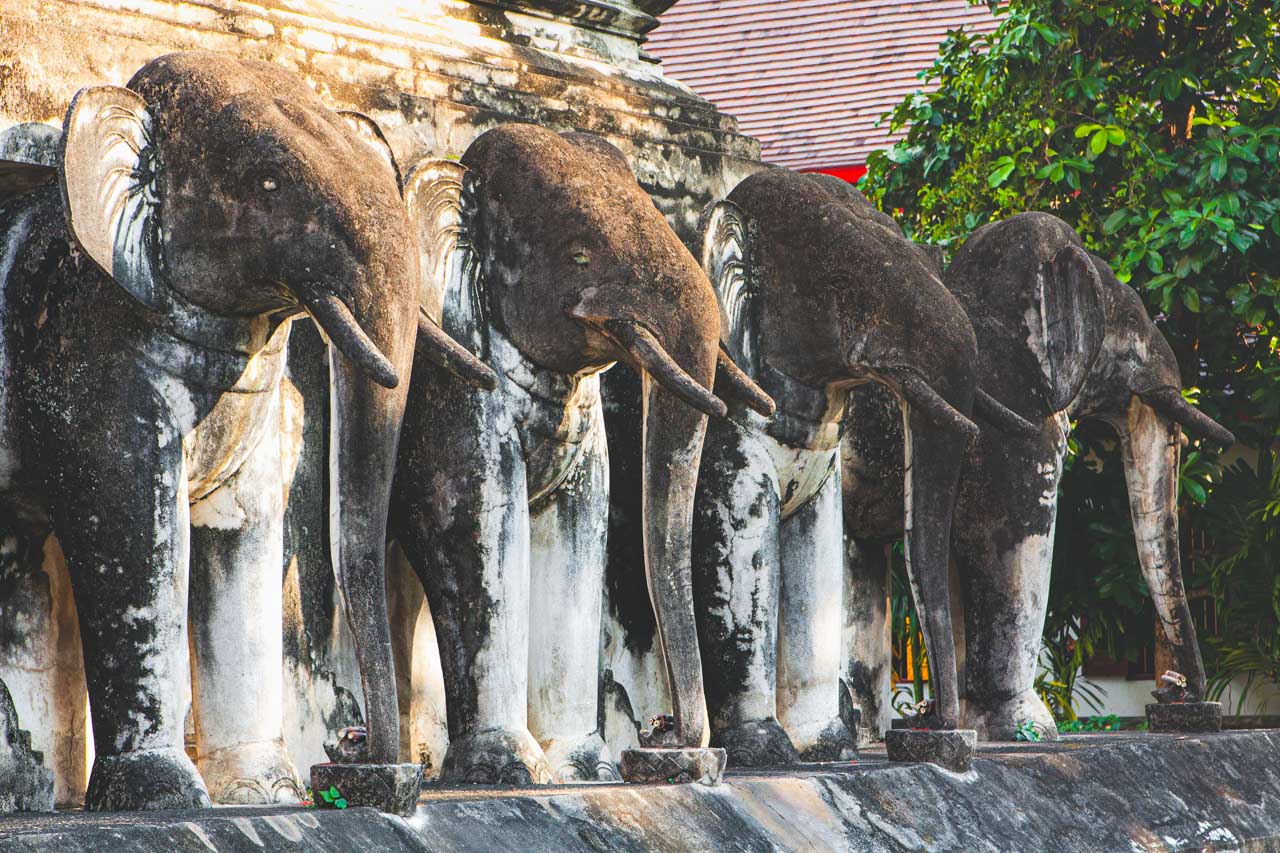
Wat Phra That Doi Suthep Temple
One of the most remarkable places in Chiang Mai is Wat Phra That Doi Suthep temple.
This is a space you don’t just look at, but experience – from the journey up to the view that opens up at the end.
The temple sits atop Doi Suthep hill, at about 1,060 meters (3,478 feet) above sea level, within Doi Suthep-Pui National Park. Thanks to this, its terraces offer a wide panorama of all of Chiang Mai.
The city stays far below, and with it the daily rush. Even if you arrive during a more touristy moment, it’s easy to find a moment of silence.
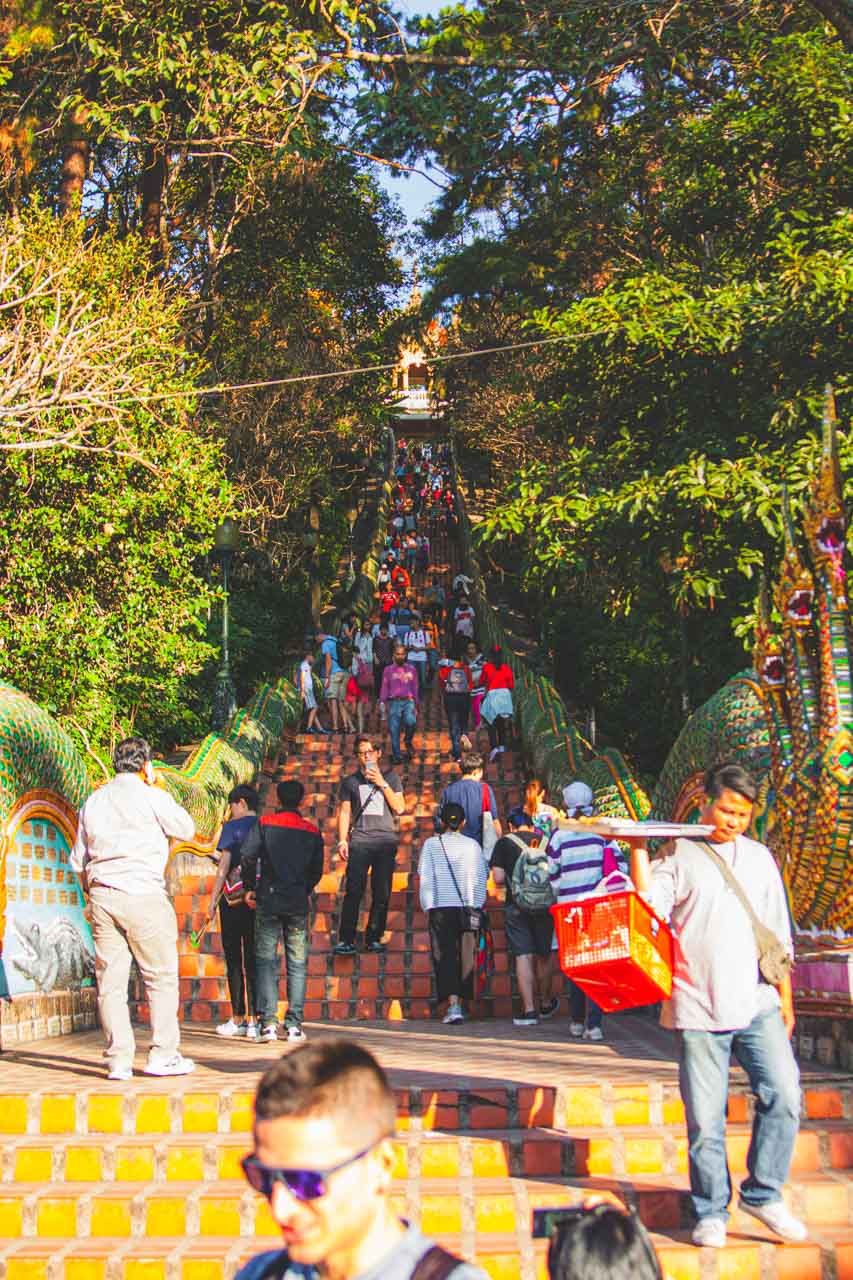
Wat Phra That Doi Suthep is a Buddhist sanctuary dating back to the 13th century, inseparably connected to local legend.
According to the story, a monk from the Sukhothai Kingdom had a prophetic dream in which he received guidance leading to the discovery of a mysterious reliquary.
After discovering the relic, he transported it to the Lanna Kingdom, where it was recognized as a sign of exceptional significance.
However, the relic was divided into two parts. The smaller fragment went to the temple in Suan Dok, while the larger was placed on the back of a white elephant, which was then released into the jungle.
The animal was meant to indicate the destination itself. According to legend, the white elephant climbed Doi Suthep hill, trumpeted three times, then fell dead.
King Nu Naone interpreted this as an omen and ordered immediate construction of a temple at precisely that spot.
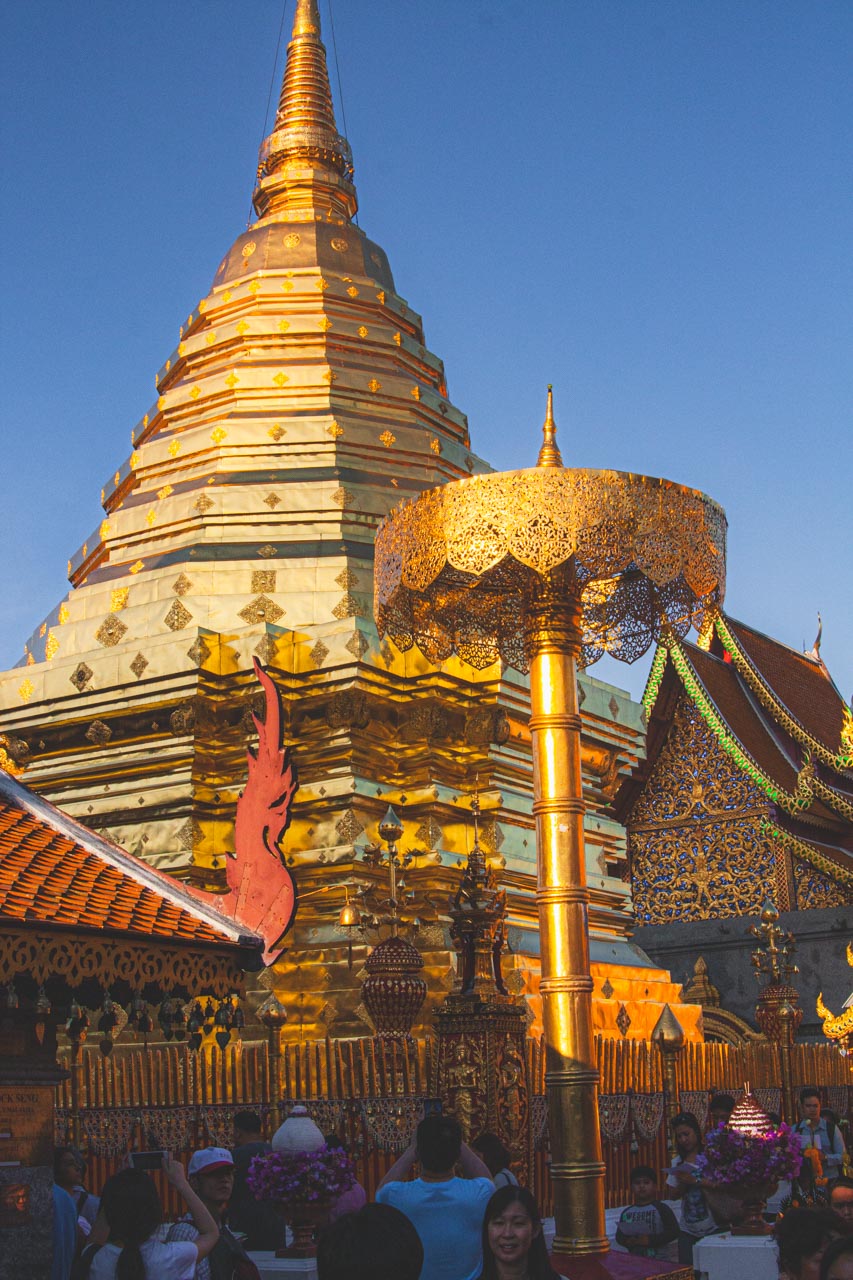
You can reach Wat Phra That Doi Suthep in several ways. The most convenient is renting a scooter, taking a taxi, or using the popular local transport called songthaew.
I chose songthaew and after brief bargaining managed to bring the ride price down to 80 baht.
From the entrance gate to the temple grounds, intricately decorated stairs with balustrades shaped like the mythical Naga serpent lead up. There are exactly 309 steps to climb.
For those who prefer to save their energy, a paid elevator is also available. The temple entrance ticket costs 50 baht.
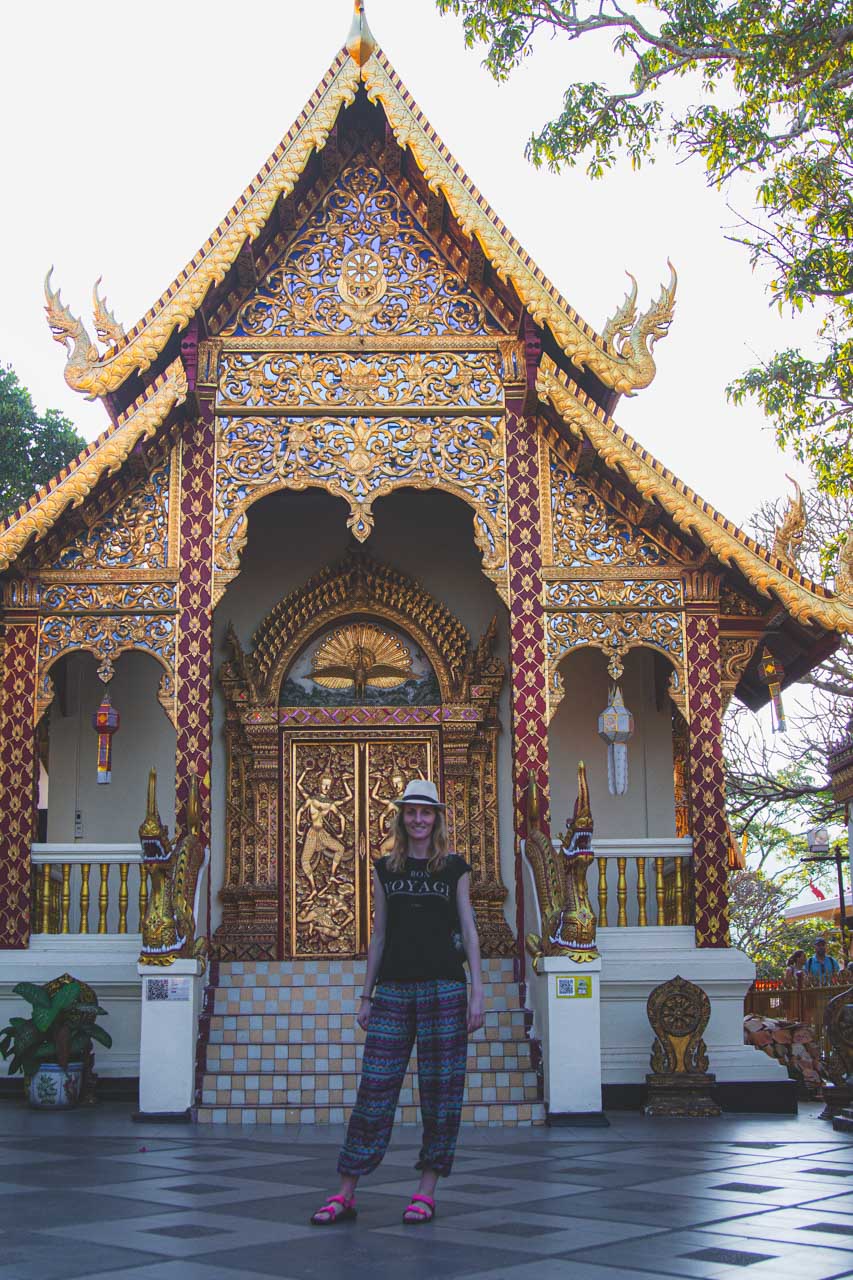
At the complex’s center is an impressive golden chedi, surrounded by delicate parasols that gently move in the wind.
In the enclosed area around the chedi, you can see beautiful paintings and a copy of the Emerald Buddha. The original is now in Bangkok, but even this version has a lot of symbolic power.
On the temple grounds also stands a figure of the Hindu god Ganesha and a statue of the legendary White Elephant, reminding visitors of this place’s origin story.
A wide walkway circling the complex leads to a large viewing terrace.
In good weather, the panorama of Chiang Mai truly takes your breath away, but even when light fog envelops the city, Wat Phra That Doi Suthep remains one of those places that stay in your memory for a long time.
Wat Inthakhin
The last temple I want to recommend in Chiang Mai is Wat Inthakhin. A place less visited by tourists, but precisely because of this having exceptional peace and authenticity.
The complex is located in the heart of the Old City and was founded over 700 years ago.
Wat Inthakhin once played a very important spiritual role. It was considered the temple of the city pillar, a place of symbolic protection and balance for Chiang Mai.
Over time, however, its significance began to wane, mainly in favor of nearby Wat Chedi Luang, which took over the role of the most important religious center in this part of the city.
During the Burmese occupation in 1775, the temple was abandoned and almost forgotten for a long time.
Today there are no crowds here or intense sightseeing atmosphere. There’s silence, shade, and a sense that this place still lives at its own rhythm.
The viharn you can see now was erected relatively recently.
It was built to properly display impressive, ancient Buddha statues that were previously kept in very modest conditions, in a simple shed.
This contrast between past simplicity and today’s form only emphasizes this place’s history.
Wat Inthakhin doesn’t try to compete with Chiang Mai’s better-known temples.
It’s more like a peaceful closing to this temple journey. The ideal place to pause for a moment and say goodbye to the city in silence.

Night Bazaar
No trip to Chiang Mai would be complete without visiting the famous Night Bazaar. This is one of those places that becomes an evening ritual for many people, even if they only stop by once.
The market is located on the eastern side of the Old City, along Chang Khlan Road, and operates daily from dusk to midnight. During the day, this street is quite calm, almost ordinary.
Only in the evening does everything change. Vendors set up stalls, lights come on, and the city starts pulsing with different energy.
At the Night Bazaar, you can find pretty much everything. From knockoff brand products, through local handicrafts, to classic Thai snacks prepared on the spot.
It’s a good place for spontaneous shopping and observing the city’s daily life after dark.
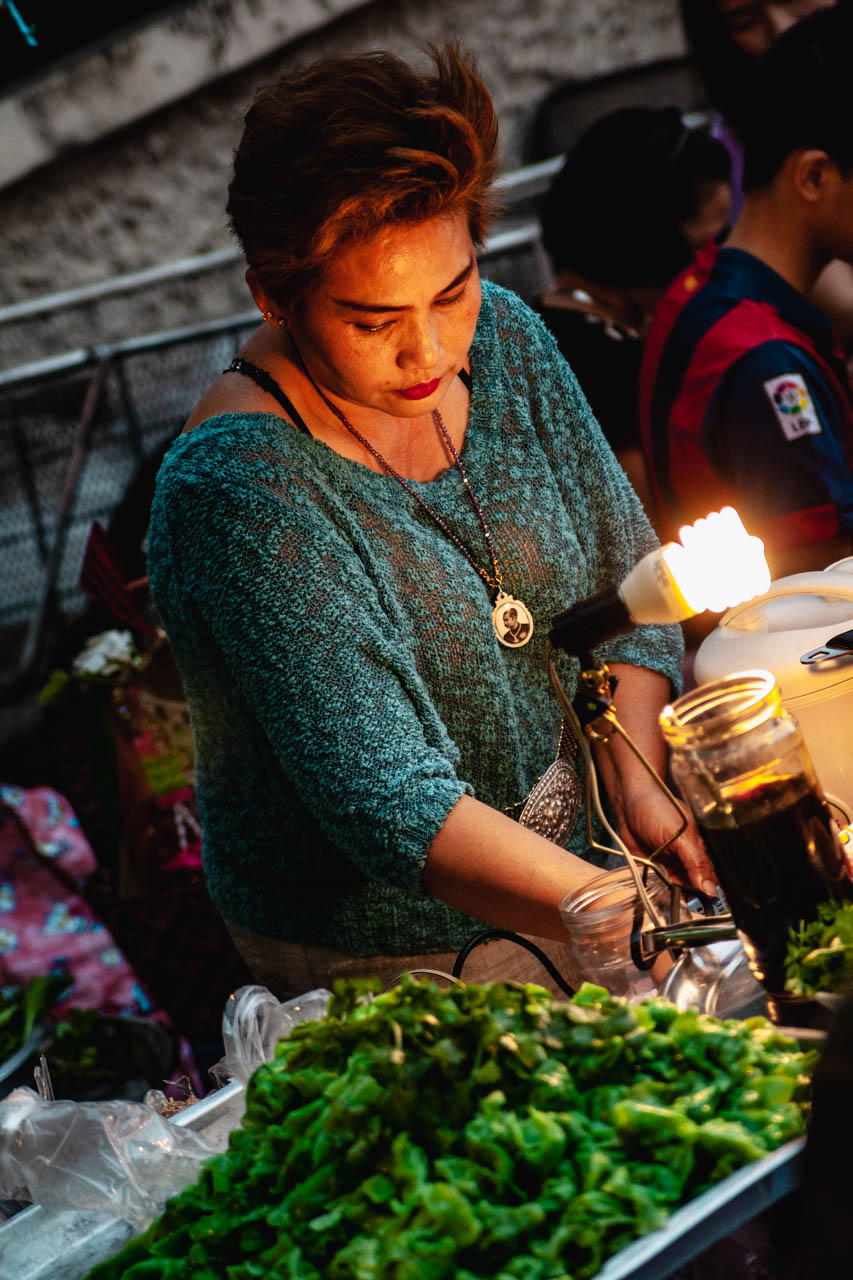
It’s worth remembering to bargain, because it’s completely natural here. Usually you can lower the initial price by about 20-30%, though this isn’t a rule.
Some vendors offer goods at fixed prices, and then negotiations simply don’t come into play.
I have to honestly add, though, that the Night Bazaar also has its less pleasant side. Wandering into side streets, it’s easy to encounter Thai bar girls trying to attract attention from tourists looking for entertainment.
For me, this was an element that disrupted the place’s atmosphere and made me not feel entirely comfortable there.
Despite this, the Night Bazaar remains an important point on Chiang Mai’s map. It’s worth seeing it at least once, consciously, with open eyes, treating it more as an experience than a mandatory attraction.

Saturday Market
If you’re in Chiang Mai on a weekend, I highly recommend checking out the local Saturday Market, also known as Wua Lai Market.
This is one of those places that lets you peek a bit deeper into the city’s daily life, beyond the main tourist routes.
The market happens every Saturday, southwest of the Old City, along Wua Lai street, from about 4:00 PM to midnight.
During this time, the entire street is closed to car traffic and transforms into a long, bustling line of stalls.
Like at the Night Bazaar, you can freely stroll, stop at selected stalls, and bargain with vendors. The atmosphere, however, is somewhat calmer and more local.
Fewer neons, more everyday life, more food prepared on the spot, and handicrafts that really come from here, not from mass production.
It’s a good place for an unhurried Saturday evening, without a plan and without pressure, with the idea that you don’t have to see everything -rather, let Chiang Mai open itself up to you.
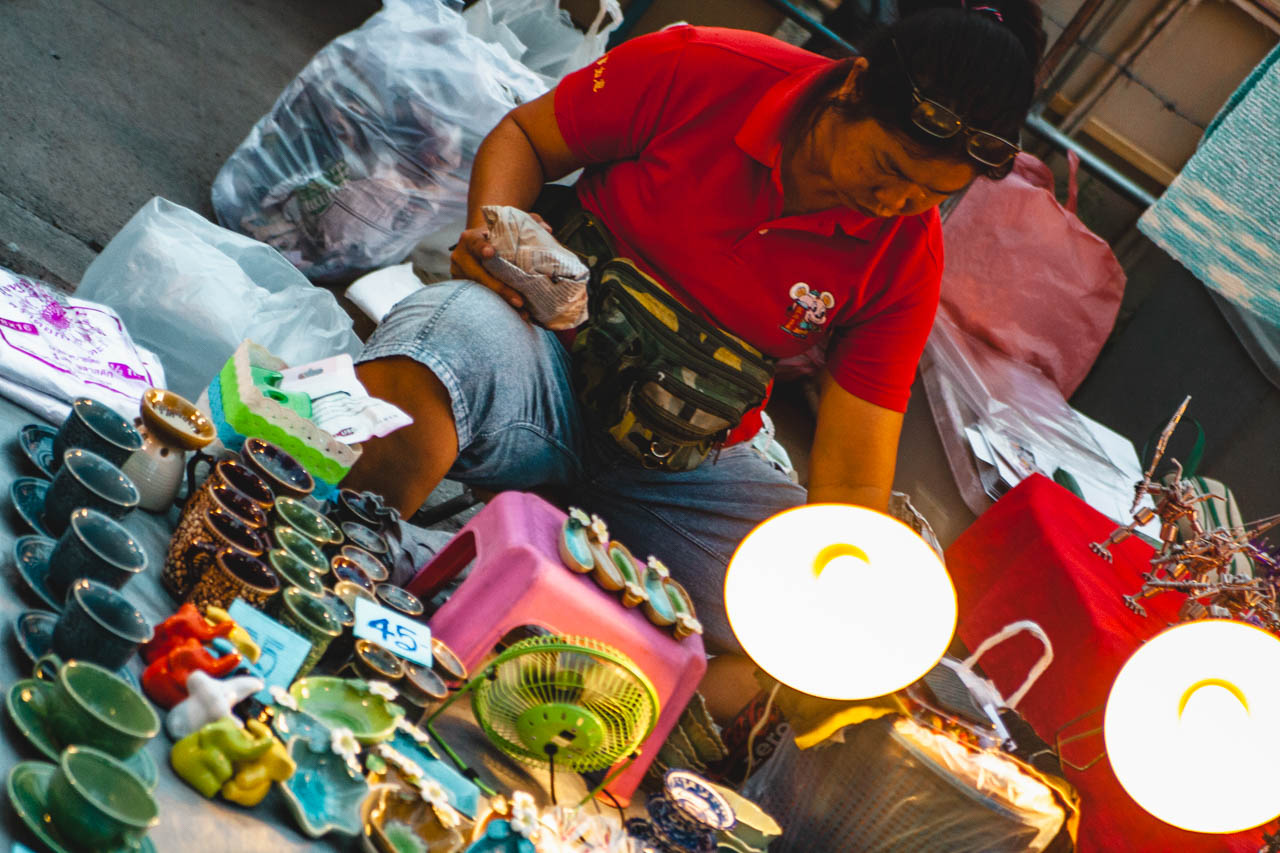
At the market, you’ll find pretty much everything you’d expect from a Thai evening market.
From silver jewelry at really affordable prices, through wooden carvings and cotton t-shirts in every possible color, to fake bags, “designer” perfumes, hand-carved soaps, and local art.
A big part of the market is food stalls. Aromas float in the air, and between the stands it’s easy to stumble on something completely spontaneous. The walk is also enhanced by street performers who give the place a loose, slightly festival-like atmosphere.
If you feel like relaxing for a moment, you can get a Thai massage. Stations are set up directly on the street, among the stalls, and prices start at around 100 baht.
It’s quite a surreal experience – massage among lights, conversations, and food smells – but these contrasts best capture the atmosphere of Chiang Mai after dark.
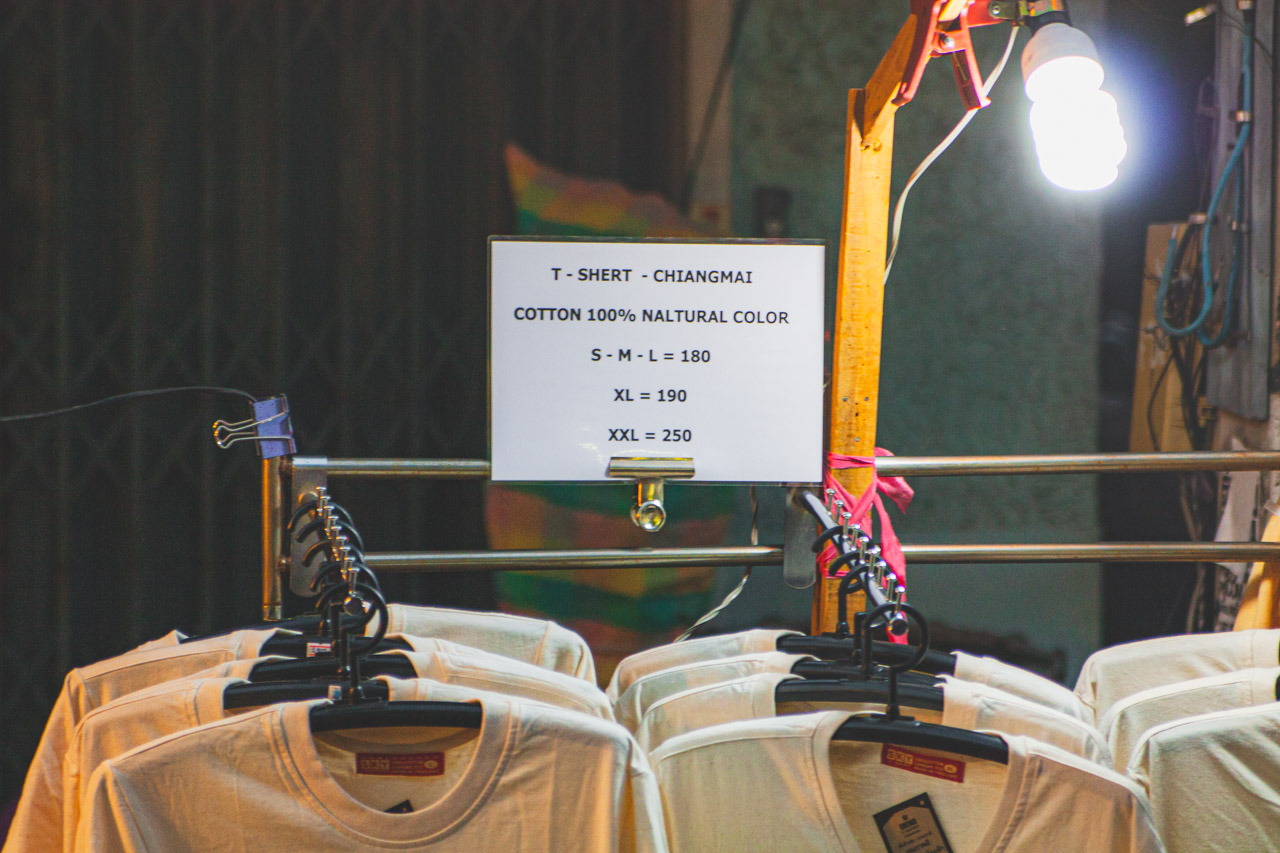
Thai Spa
Chiang Mai is mainly associated with temples, but it’s also one of the most important places on the Thai massage map.
This is where the Royal Massage Academy operates, and in the city itself you’ll find over two hundred spa salons, from very simple to refined, intimate spaces.
If you want something more conscious and calm, I highly recommend Fah Lanna Spa.
This is a small, refined place run by friends who focus on ecology and genuinely support refugee children’s education.
You feel good energy from the very entrance, without excessive luxury, but with great mindfulness.
The spa is located in the Old City center and is open daily from 12:00 PM to 9:00 PM. It’s worth booking a visit at least one day in advance.
Fah Lanna offers twenty-five private treatment rooms and free transport to and from the hotel, which is a big plus, especially after a long day of sightseeing.
Upon arriving at the spa, you’re greeted by staff with tea and fill out a short health questionnaire. There are about fifty different treatments to choose from, so it’s easy to match something to your needs and mood.
If this is your first time, I recommend the classic Thai massage. It begins with foot washing, and the entire treatment takes place in a private room.
Massage therapists work not only with their hands, but also with feet, thumbs, elbows, and forearms. It’s an intensive massage, but very effective – after which your body really lets go.
After the treatment, you can stay a while in the spa cafe and have tea. This is that moment when nothing is needed anymore, and Chiang Mai shows its softest side.
How do you want to explore Thailand?
🍜 Culinary experiences → Thai Farm Cooking School – amazing cooking lesson in Chiang Mai
🏙️ City adventures → What to see in Bangkok – top attractions and restaurants
🏛️ Historical discoveries → Ayutthaya in one day – best attractions
🗺️ Complete travel itinerary → Thailand guide with complete itineraries
What attracts you most?
Thai Farm Cooking School
While in Chiang Mai, it’s really worth signing up for a cooking class. This is one of the best ways to understand local culture from the inside, not just through restaurant menus.
Thai Farm Cooking School is one of the places that does this in a very natural and authentic way.
I participated in this course and can say without hesitation that it was the best cooking lesson I’ve ever attended.
Without rushing, without pressure, with enormous respect for ingredients and the process itself.
The class begins with a visit to a local, organic farm. Participants pick fresh ingredients themselves, like lemongrass or papaya, which they later use during cooking.
This is a moment that really changes perspective. Suddenly dishes that until now you only associated with a plate start to have their own smell, texture, and story even before they reach the kitchen.
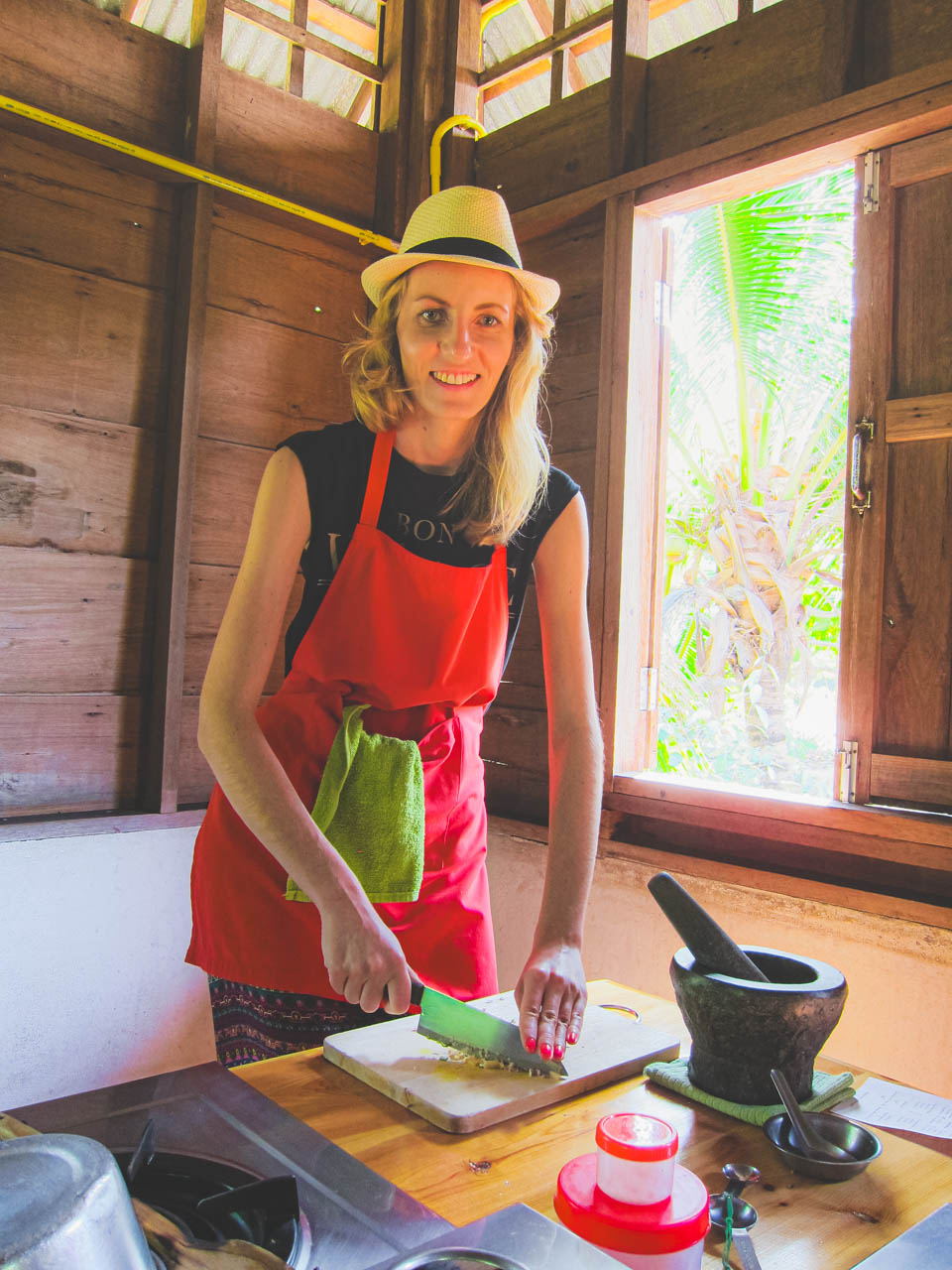
Classes take place outdoors, surrounded by greenery, which immediately gives them a unique atmosphere.
Cooking in such a place feels completely different. Without a closed kitchen, without a clock overhead, but with scents, sounds, and the calm rhythm of the day.
During the course, you prepare six dishes, including classic Thai curry and sticky rice with mango.
Everything is explained step by step, but without rigid structure. There’s space for questions, trying, correcting, and tasting as you go.
The course price includes refreshing drinks and a small cookbook you can take home. It’s a nice addition, but really the most important things stay in memory and in your hands.
Movements, proportions, the way of working with ingredients.
Thai Farm Cooking School is more than a cooking lesson. It’s a calm immersion in Thai cuisine and culture that stays with you long after returning.
One of those experiences you really bring back with you, not just remember in photos.
Want to know more about Thai flavors? Check out my list of 10 dishes you absolutely must try in Thailand.

Where to Eat in Chiang Mai
Mr Kai Restaurant
While in Chiang Mai, it’s really worth planning dinner at one of the places I remember best from all of Thailand. Mr KAI Restaurant is a restaurant you think about long after leaving.
You can see this place’s phenomenon right away. A line almost always forms before the entrance, and the room fills up quickly. This isn’t a trendy “Instagram” spot, but a place that defends itself with food and atmosphere.
If you see a crowd patiently waiting for a table, that’s a good sign. In Chiang Mai, this usually means it’s worth the wait.
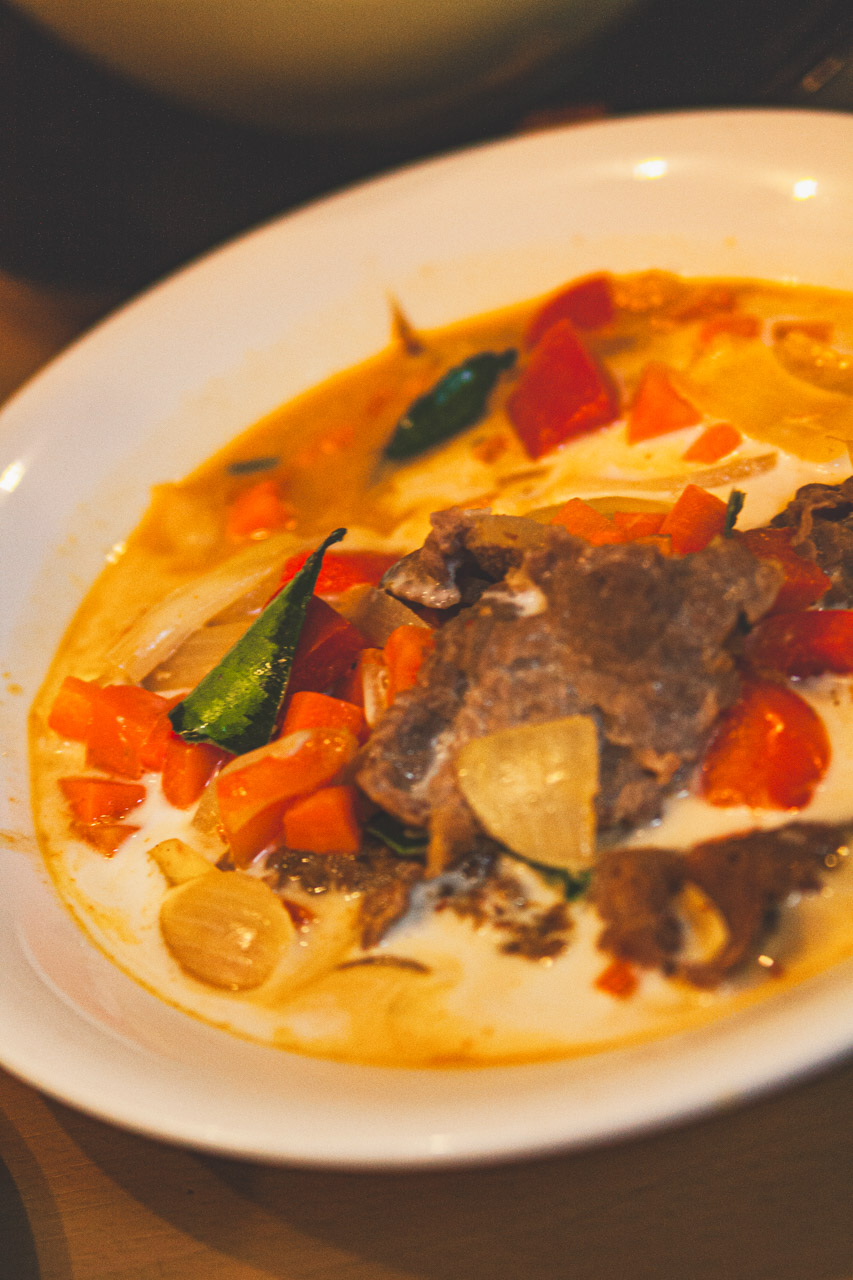
Fortunately, once you manage to find a table and place an order, everything happens surprisingly fast.
Food appears almost immediately, and you’re served by a smiling crew or Mr. Kai himself, which only adds character to the place.
The regional khao soi soup, vegetarian tofu curry, and seafood risotto completely stole my heart. Each dish was refined, full of flavor, and without unnecessary gimmicks.
Everything I tried here was really delicious, served in generous portions, and at very affordable prices.
This is one of those places where you leave full, satisfied, and with the feeling that you ended up exactly where you needed to be.
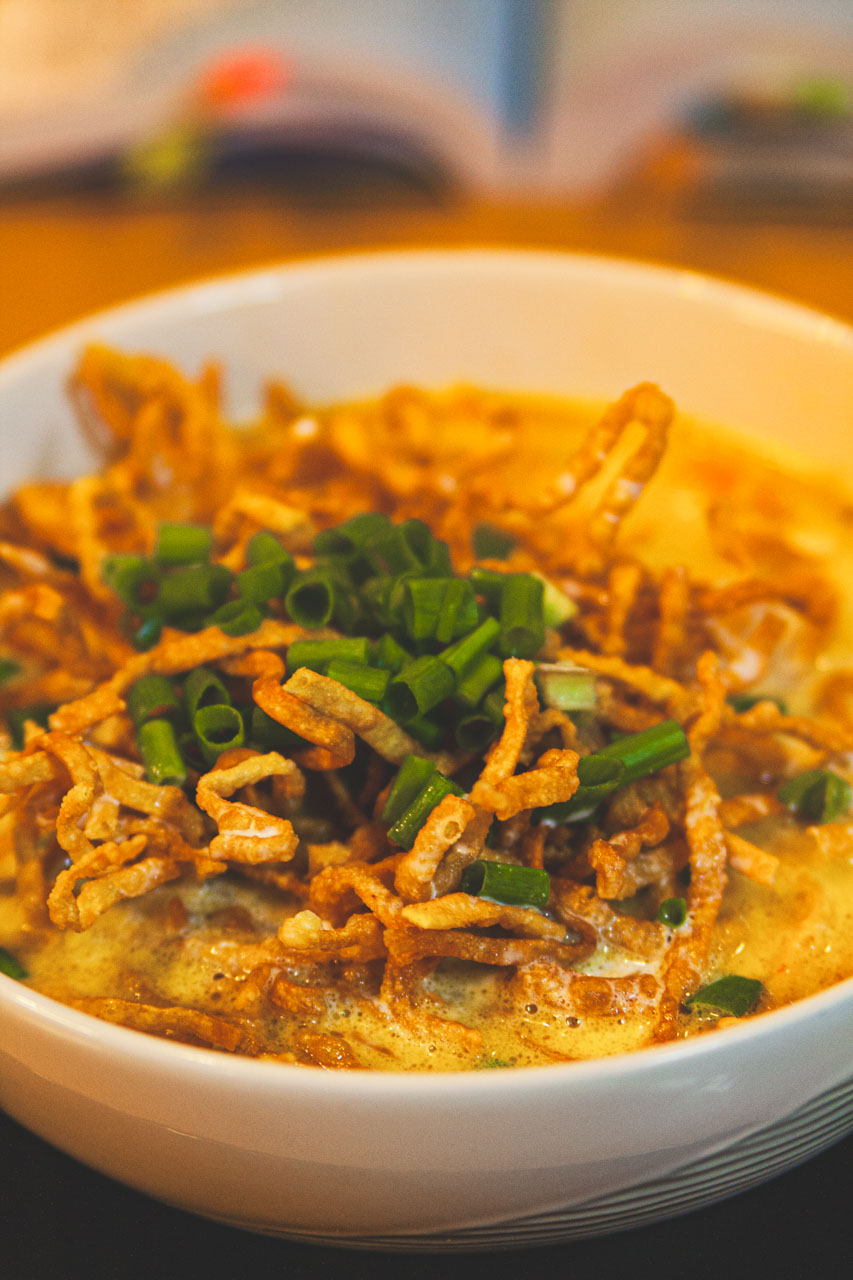
Hanna Restaurant & Coffee Shop
Another place I liked returning to in Chiang Mai is Hanna Restaurant & Coffee Shop. This is a small, very friendly cafe, ideal for a peaceful breakfast or light lunch while sightseeing the city.
The place has a relaxed, unpretentious atmosphere where it’s easy to sit for a while, without rushing and without feeling like you need to free up the table soon. It works great as a stop during the day.
I especially recommend their iced coffee, which can save the day in Thai heat, and vegetarian spring rolls.
Simple flavors, well-made food, and the kind of atmosphere that makes even an ordinary meal become a nice moment in the journey.
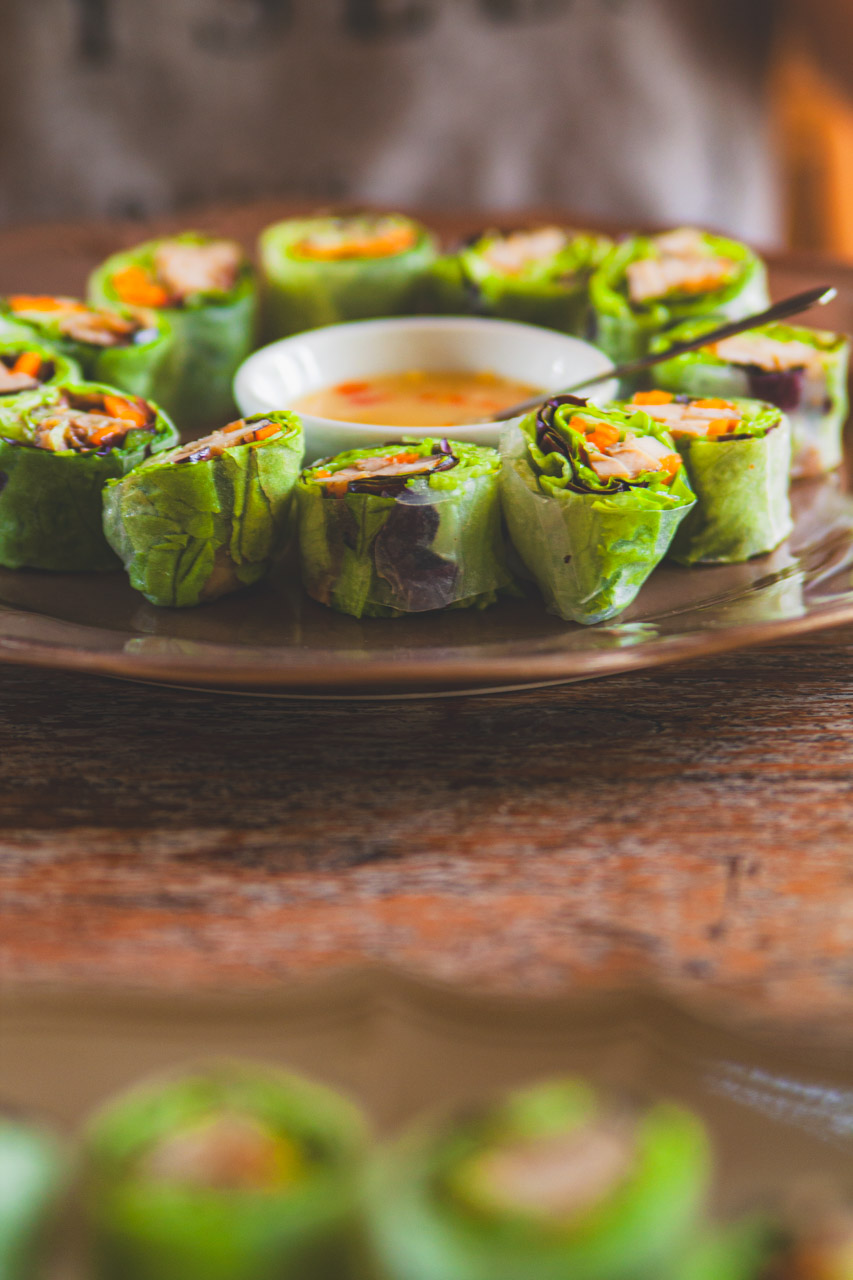
Elephants in Chiang Mai: What You Need to Know
Chiang Mai is one of the places in Thailand most strongly associated with elephants. And that’s exactly why it’s worth approaching this topic carefully.
There are many elephant-related attractions here, but not all are good for animals or people.
Places still operate offering elephant rides or trick shows.
Unfortunately, such attractions very often involve brutal training methods, including phajaan – the process of breaking young elephants’ psyche.
This is something you don’t see in photos, but which stays with these animals for life.
Instead, it’s worth choosing ethical sanctuaries that focus on elephant welfare and allow them to live in as natural conditions as possible.
The best known include Elephant Nature Park, Elephant Jungle Sanctuary, and Burm and Emily’s Elephant Sanctuary.
These are places where elephants aren’t used for riding or performances, and contact with them happens on their terms.
In many such sanctuaries, you can also volunteer and help with daily activities like feeding or bathing elephants.
This is a completely different experience than a tourist attraction. More about observing, learning, and being alongside, than about “checking off” another program point.
If you don’t have the opportunity to visit a sanctuary, you can also support them financially. Even small support really helps improve these animals’ fate.
In Chiang Mai, you really can meet elephants in an ethical and calm way.
It’s worth choosing places that don’t offer rides or shows, because behind such entertainment almost always lies suffering. Conscious choices in travel matter, even if they seem small.
If you’re wondering why elephant rides are a bad idea, read my article: 10 reasons why you shouldn’t ride elephants.
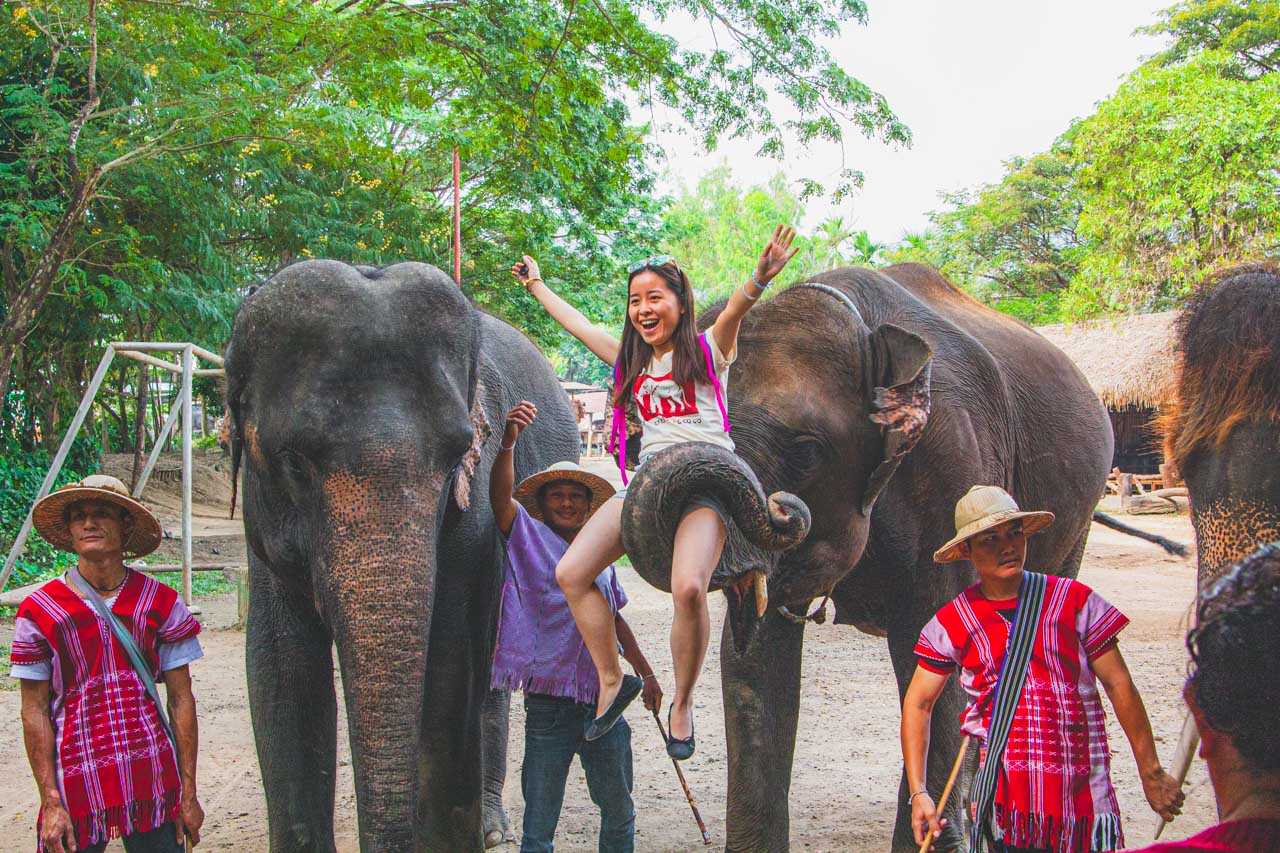
How to Get to Chiang Mai from Bangkok
You can reach Chiang Mai from Bangkok in several ways. It all depends on how much time you have and whether you treat travel as a means to an end or as part of the experience.
By Plane
The fastest and most commonly chosen option is flying from Bangkok to Chiang Mai. Planes depart from both Suvarnabhumi and Don Mueang airports, and the flight itself lasts just over an hour.
Ticket prices usually start at around $30-40 (about 1,000-1,400 baht), though they can change depending on season, airline, and availability.
This is a good option if you want to save time or have a tight travel schedule.
By Train
If you like slower journeys and want to see Thailand from a train window, it’s worth considering rail travel. Direct trains run from the new Krung Thep Aphiwat Central Terminal station in Bangkok to Chiang Mai.
The journey takes about 11-13 hours, and ticket prices range roughly from 800 to 1,900 baht, depending on class and type of car.
The most convenient option is night trains with berths, which save you accommodation and let you arrive rested.
It’s worth remembering that Krung Thep Aphiwat is currently the main station for long-distance connections, but some routes may still be served from Hua Lamphong station. Good to check this before buying a ticket.
By Bus
The most budget option is traveling by bus. Connections run mainly from Mo Chit station in Bangkok, and the ride to Chiang Mai takes about 10-12 hours.
Ticket prices start at around 500 baht and can reach 1,000 baht, depending on the bus standard.
Comfort varies greatly, so it’s worth paying attention to reviews and choosing a better class, especially for night travel.
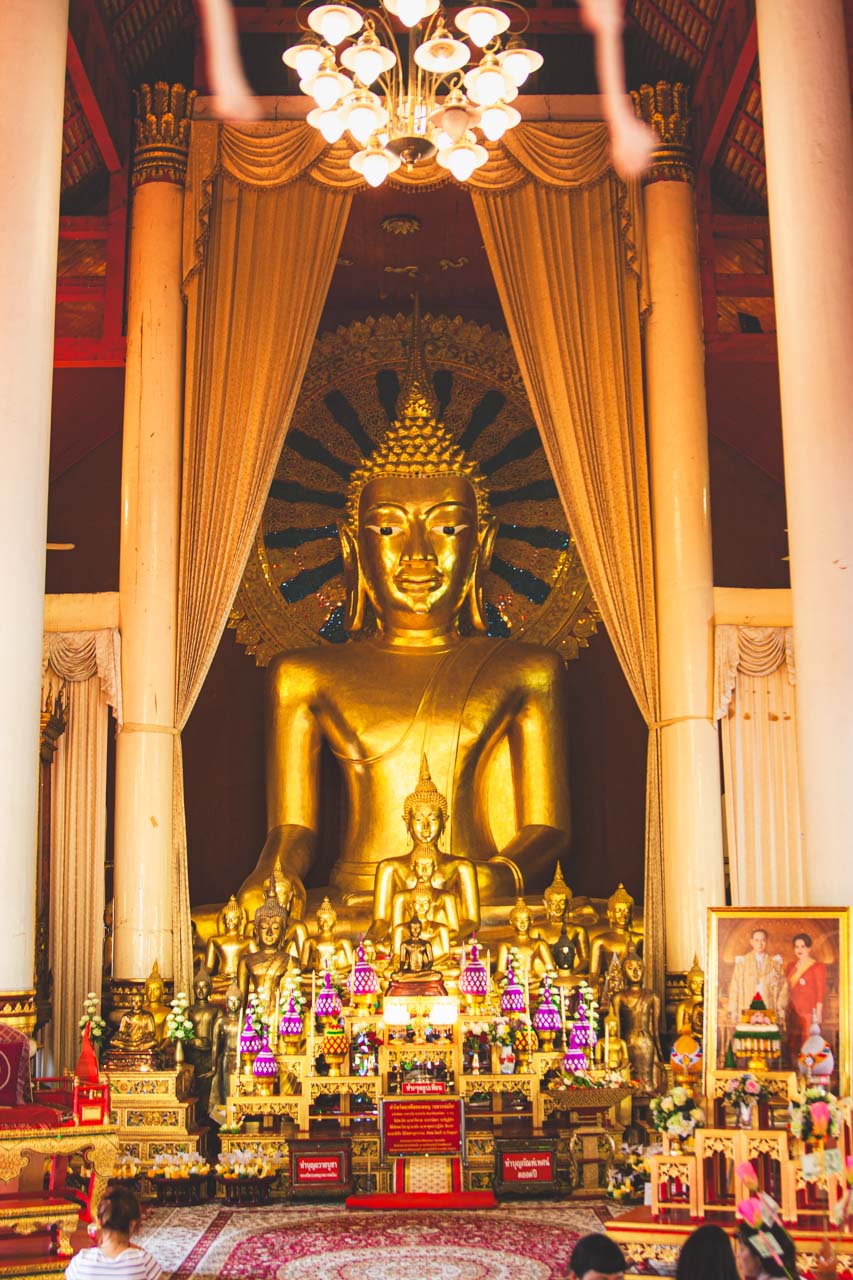
When’s the Best Time to Go to Chiang Mai
If you want to see Chiang Mai at its friendliest, it’s best to plan your trip during the cool, dry season – between November and February. This is when the city breathes easiest.
Temperatures are more bearable then, humidity is noticeably lower, and rainfall is rare.
Thanks to this, walks through the old city, temple visits, and evening markets become pure pleasure, without battling heat and rain.
This is also the period of the most beautiful local festivals. In November, Loy Krathong takes place – the festival of light and water, when rivers and sky fill with lanterns.
At the beginning of the year, the city blooms during the Flower Festival, which perfectly fits Chiang Mai’s calm, northern Thai atmosphere.
Traveling at this time isn’t just about good weather, but also a chance to experience local traditions in their most natural form.
If you can choose your dates, these months will let you feel Chiang Mai most fully.
Before leaving, it’s also worth reading about 10 things to avoid in Thailand so your trip goes smoothly.
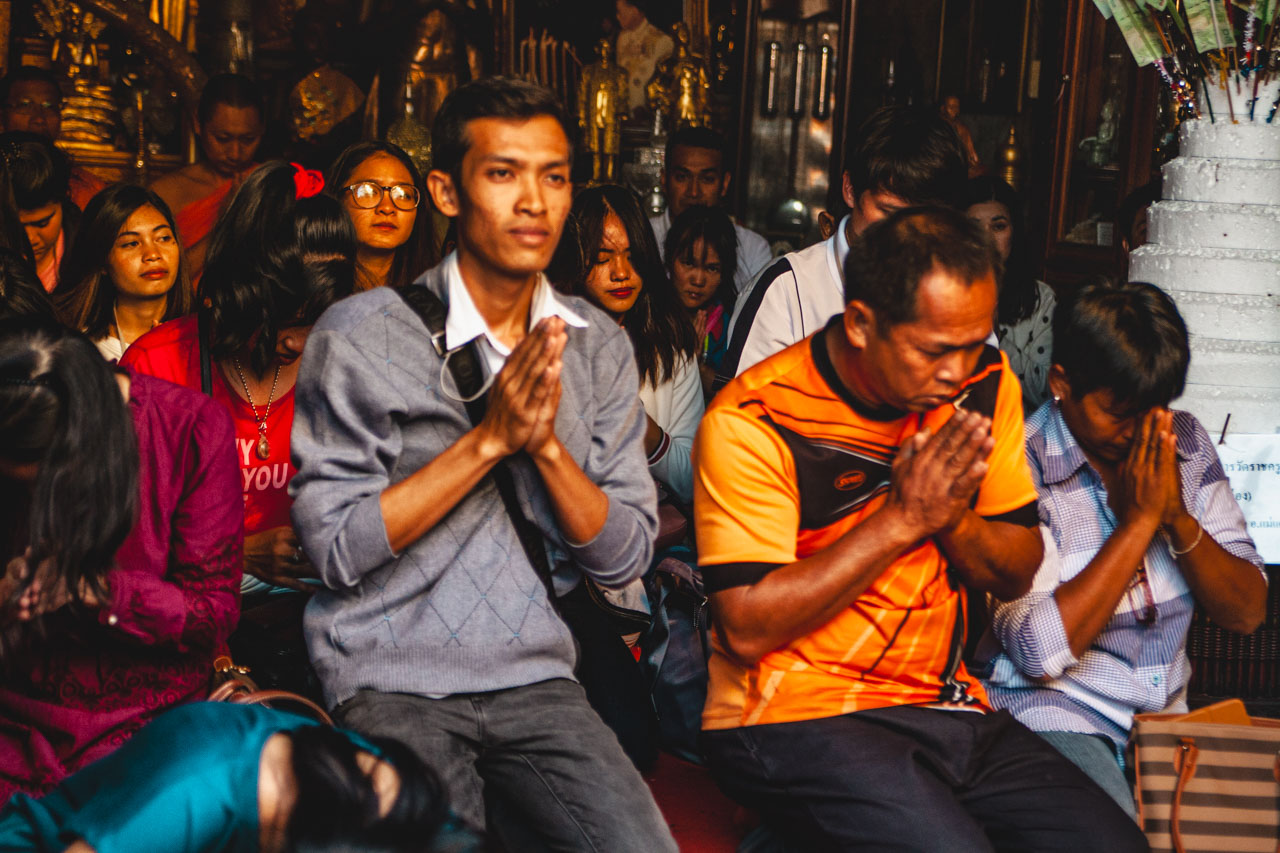
Travel Budget Calculator
Get your free Travel Budget Calculator now and plan your trip without the stress of overspending!
Where to Stay in Chiang Mai
Chiang Mai gives you a lot of freedom of choice when it comes to accommodation. Everything depends on how you want to experience the city and at what pace you’re traveling.
If you care about being close to temples, markets, and old city daily life, the best choice will be accommodation within the Old City walls.
This is where it’s easiest to get around on foot, drop into temples in the morning, and return for a moment of rest during the day.
You’ll find both simple guesthouses, atmospheric boutique hotels, and more comfortable, quiet places hidden in side streets.
If you prefer a more modern vibe and a bit more space, it’s worth considering the Nimman district. This is a part of the city full of cafes, boutiques, and galleries, with a relaxed, creative atmosphere.
Nimman is a good choice if you like good food, design, and calmer evenings, while still wanting easy access to the center.
For those seeking quiet and contact with nature, an interesting option is Chiang Mai’s outskirts. This is where you’ll find resorts located among greenery, in the countryside, or along the Ping River.
Such accommodation encourages slowing down and resting, especially if Chiang Mai is one stop on a longer route.
Below you’ll find several proven accommodation options in Chiang Mai, in different price ranges, to make it easier to match something to your own travel style.
Recommended hotels in Chiang Mai:
- Budget-friendly option: BED Phrasingh-Adults Only
- Mid-range option: The Rim Chiang Mai
- Luxury option: Four Seasons Resort Chiang Mai
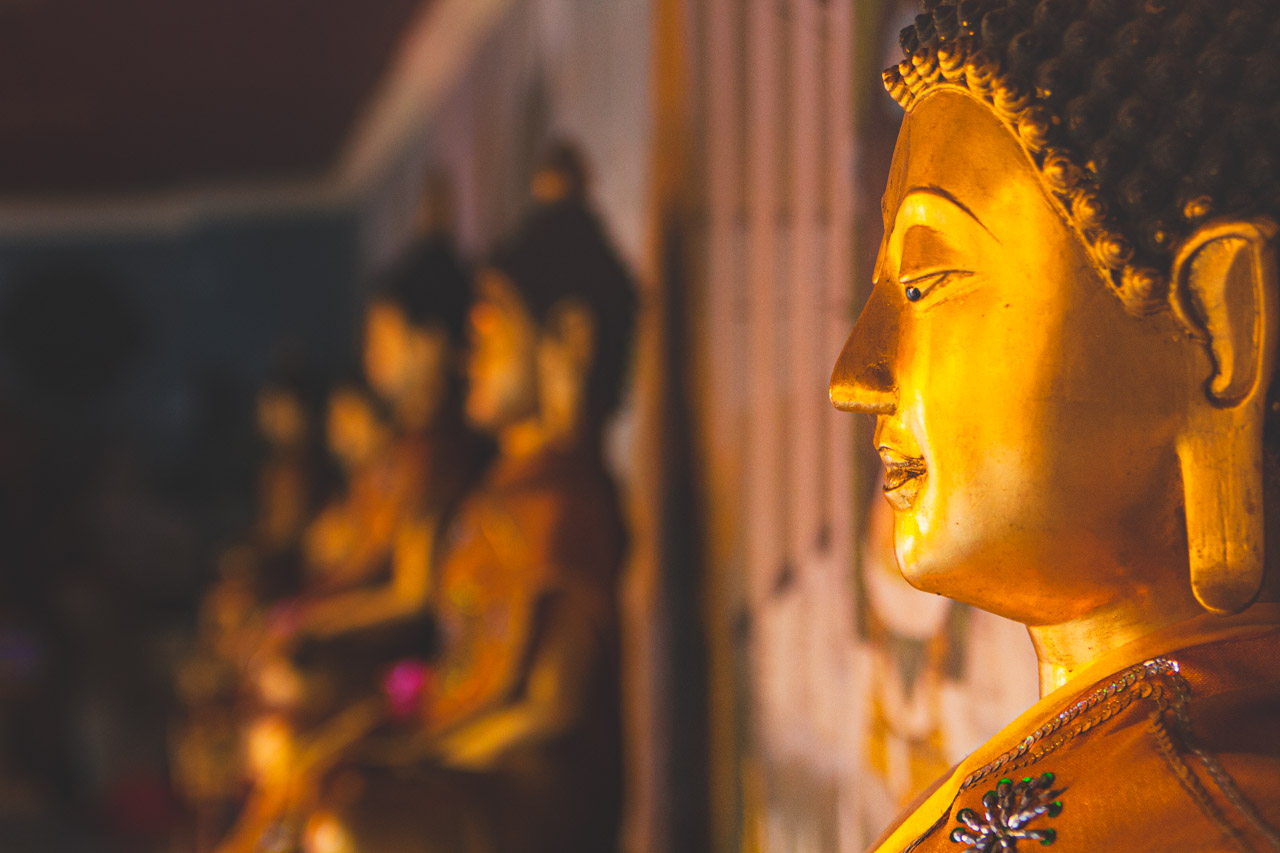
Chiang Mai Will Stay With You for a Long Time
A few years ago, when I first went to Chiang Mai, I had a regular list of attractions to “check off.” Temples, markets, a cooking class. Classic tourist plan with guidebook in hand.
And then I sat in the wooden Wat Phan Tao temple, in the afternoon silence, and understood that this city works differently. It doesn’t shout. It doesn’t push. It just waits until you slow down and notice.
Chiang Mai has something about it that’s hard to describe with a photo or proven route. Maybe it’s the smell of incense mixing with Thai coffee aroma. Maybe the peace you feel even at a crowded market.
Or maybe simply the fact that here, in northern Thailand, you can still feel a rhythm that doesn’t adapt to the rest of the world.
If you give this city time, it gives you something in return. Not just photos and memories, but perspective that travel doesn’t have to be a race.
Sometimes the best things happen when you sit for a moment and just observe.
Ready for more Thai adventures?
- Complete Thailand guide – everything you need to know before leaving
- What to Do in Bangkok – discover Thailand’s capital
- Koh Samui Guide – paradise island in the Gulf of Thailand
- 5 Days in Krabi – perfect tropical getaway plan
Which place in Chiang Mai intrigued you most? Share in the comments – I love reading about your impressions and travel plans.
If this guide was helpful, share it with a friend who dreams of Thailand. Honest advice works best when it travels between friends.
This article contains affiliate links. If you make a booking through these links, I may earn a commission, supporting this blog. Rest assured, my recommendations are based on honest assessments, and using these links doesn't affect prices for you. Thank you for your support!
